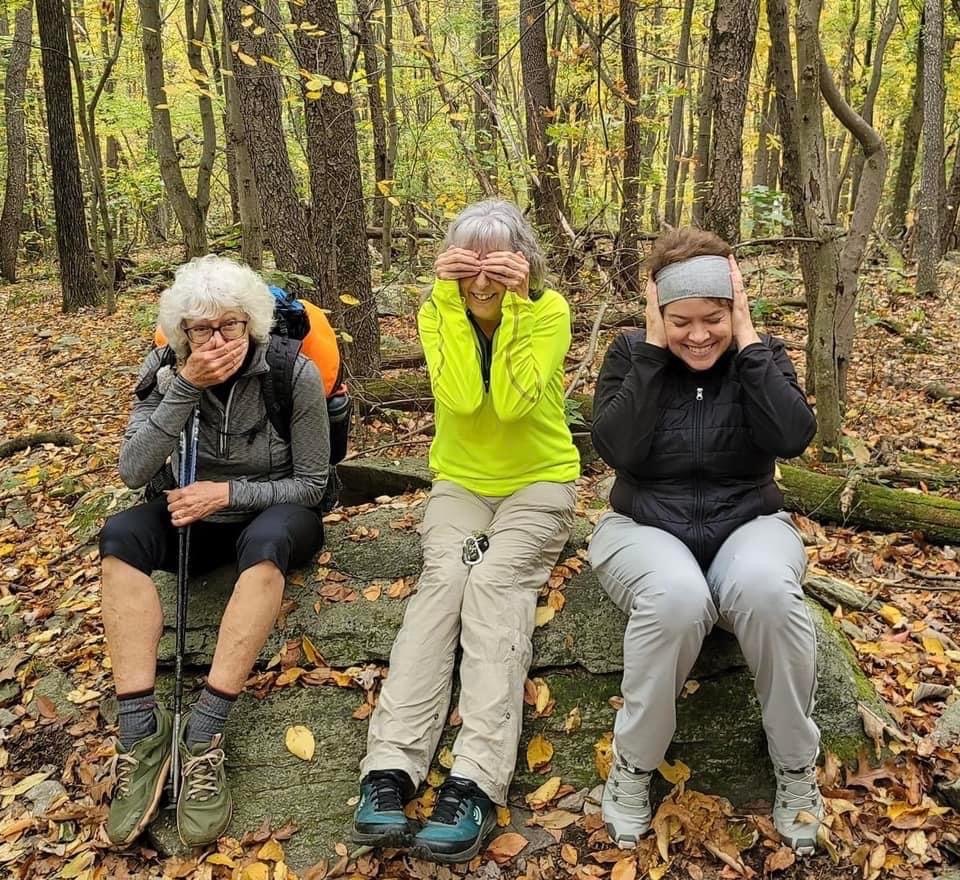By Morgan Sommerville, ATC Director of Visitor Use Management
Essential Tips for Senior Hikers: Hiking the Appalachian Trail in Retirement
June 27, 2024
As the Director of Visitor Use Management at the Appalachian Trail Conservancy, and someone who is approaching retirement, I am pleased to see an increasing number of retirees taking on the challenge of thru-hiking the Appalachian National Scenic Trail (A.T.). I had the opportunity to thru-hike the A.T. in my 20s. This wonderful, life-changing trip inspired me to dedicate my career to building and improving the Trail.
An A.T. thru-hike or section hike will likely provide some good camaraderie, excellent physical exercise, and wonderful peace and quiet while enjoying the tranquility and beauty of nature. For those considering this ambitious undertaking, here are some essential tips to ensure a safe and enjoyable journey.
Prepare Your Body

Photo by Mike Hoffman near Bretton Woods, New Hampshire
Embarking on a thru-hike is no small feat, and preparation makes all the difference in a successful thru-hike attempt. Start by incorporating lots of walking into your daily routine. Walking downhill is as important as walking uphill as there are an equal number of both on a thru-hike, some of them steep.
Once you’re comfortable, transition to hiking on trails working up to carrying a pack similar in weight to what you’ll carry during your thru-hike. This year’s northbound thru-hikers are averaging pack weights of 33.9 lbs (this includes food and water), so aim for something similar to get accustomed to the load. Another way to cut weight is to lose body weight, if appropriate; ultra-light backpackers stress over a few ounces of pack weight, but you’ll get the same benefit from losing a few ounces of body weight.
See more 2024 Northbound Thru-Hiker Stats and Facts:
In addition to walking and hiking, incorporate exercises and stretches that promote flexibility and strengthen your knees and quads. Core and upper body strength are equally important, as they help maintain balance and support your back. Exercises that enhance side-to-side stability are crucial as well, given the uneven terrain you’ll encounter on the A.T.
Don’t forget to take some “test” backpacking trips to really get the feel for an A.T. trip, and most importantly, to test out all your gear in the field and your comfort level with camping. Some beginning A.T. thru-hikers determine it wasn’t what they were looking for—and you might as well figure that out closer to home.
Explore Alternate Thru-Hike Routes

Photo showing Paul Burks in Mahoosuc Notch, Maine. Photo by Jason Burks.
Consider a flip-flop thru-hike, which involves starting in the middle of the Trail, hiking to one end, returning to the middle, and then hiking to the other end (there are countless variations!). This approach offers several advantages over traditional northbound or southbound hikes. You’ll enjoy milder weather, avoid the crowded northbound “bubble” of thru-hikers in the spring, and have a more flexible timeframe to complete your journey. Starting in Harpers Ferry, the ATC’s Headquarters, you can enjoy the more moderate terrain of the Shenandoahs and Maryland, known for smaller elevation changes and smooth treadways.
Listen to Your Body
Taking care of your body is paramount. Plan for “zero days”—days off (or on) the trail to rest—at least once a week. Don’t ignore any pain or discomfort; addressing issues early can prevent hike-ending injuries.
For first-time thru-hikers, it’s wise to start slow. Be sure to take it easy for the first few days. It’s okay not to make your initial mileage goals if it doesn’t feel right. Limit your daily mileage to 8-10 miles for the first couple of weeks to allow your body to adjust to the demands of continuous hiking. Gradually increasing your mileage can help avoid overuse injuries and fatigue. And, often overlooked, be sure to drink plenty of water—you’ll feel better and your joints will be happier.
Connect with Past A.T. Thru-Hikers

Photo by Anita “Low Gear” Smith near Duncannon, Pennsylvania
Connecting with past thru-hikers, especially those of similar ages and backgrounds, can provide invaluable insights. The ATC maintains affinity lists of people who recently completed the A.T., covering various experiences and topics. These lists are not available online, but you can request a copy by emailing info@appalachiantrail.org. Here are some examples of affinity groups:
- Cancer Survivors: Hikers who were in recovery or undergoing treatment.
- Couples: Couples that hiked the Trail together.
- Day-hike/Slackpackers: Hikers with logistical support who spent few or no nights on the Trail.
- Diabetic Hikers: Including insulin-dependent diabetics.
- Disabilities and Injuries: Hikers with conditions like heart disease, scoliosis, or kidney transplants.
- Dog Owners: Hikers who brought their canine companions.
- Late Starters: Northbound thru-hikers starting in Georgia in May or June.
- Military Veterans: Including those injured during service.
- Over 55: Hikers currently aged 55-77.
- Section Hikers: Those who took more than 12 months to complete the Trail.
- Slower Hikers: Hikers who took more than 7 months to complete a thru-hike.
- Vegetarian/Special Diet: Including vegetarians, vegans, and those who dehydrated their own food.
Embrace the Journey

Photo by Jay Davison at Katahdin, Maine
Thru-hiking the Appalachian Trail is a remarkable achievement at any age, and your retirement years can be the perfect time to embark on this life-enhancing adventure. The A.T. is not like a city park trail, it can be rough and tough. By preparing your body, considering alternative routes, listening to your body, and connecting with past hikers, you can ensure a safe and fulfilling experience. Happy trails!
For more information, feel free to contact us at info@appalachiantrail.org.
Discover More

Plan and Prepare
Day Hiking
Ready to begin exploring the Appalachian Trail? Here’s everything you need to know to plan your next (or first) day hike.

Know Before You Go
Hiker Preparation Series
Before heading out to the Appalachian Trail for your long-distance hike, check out our hiker preparation series for tips and checklists on how to have a safe and enjoyable A.T. experience.

Plan and Prepare
Hiker Resource Library
A collection of resources for hikers to stay safe, healthy, and responsible on the Appalachian Trail.
